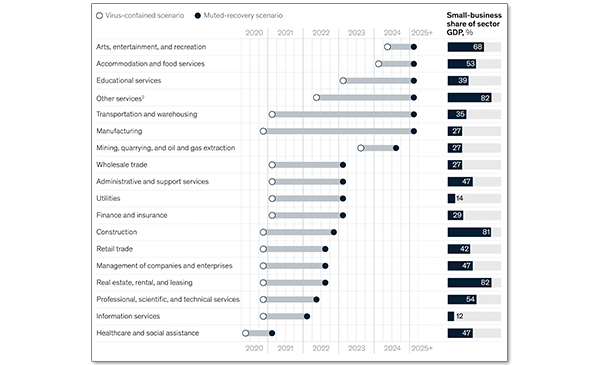
Industry experts explore the email marketing trends set to impact your strategy in 2021 and consider how COVID-19 has permanently and positively changed email marketing
In 2020, email marketing trends, like so many parts of our work and personal lives, had to undergo a rapid transformation.
As the pandemic continues to lead to wide-ranging changes to the way consumers perceive brands and consider purchases, email marketers have adapted in many innovative and inspiring ways heading into the new year.
In this article, we'll review five of the brightest minds from the world of email marketing provide their key trends for 2021. With email continuing to play a vital role in nurturing, acquiring and retaining customers, it’s time to explore the opportunities that lie ahead.
Tip 1: Email marketing through the K-shaped COVID-19 recovery
As we head into 2021, COVID-19 continues to impact marketing strategies and budgets within organisations of all sizes and industries.
Its impact on different nations and demographics has been hugely varied. In the marketing world, this has also been the case - as some COVID-proof industries have prospered, others have been forced to shut their doors, drastically cut budgets and enter survival mode due to the restrictions put in place.
McKinsey analysis shows just how that is expected to play out for different sectors, with the recovery potentially taking more than five years for the hardest hit

Source: Oxford Economics, McKinsey analysis, McKinsey Global Institute analysis 1. Data as of June 15, 2020 2. Excluding public administration
With this data in mind, it’s clear that there’s no longer a “one-size-fits-all” solution when it comes to managing your email marketing in 2021.
Yes, there are innovative email marketing solutions and tools all around us, leading us ever closer to being able to deliver 1-to-1 personalisation across our digital marketing through the use of AI.
However, for many of you, investment in these kinds of technologies may not be possible right now (nor was it on the cards pre-COVID). You need to search for tactics that are right for your business.
“Email marketing trends in 2021 will be driven by the K-shaped recovery from the pandemic that has seen some companies excel while others struggle.
Supermarkets, e-tailers, digital entertainment providers, tech providers, and other companies that have done well will focus on better personalisation, segmentation, and automation as they inch closer to achieving the 1-to-1 marketing paradigm.
Some of those improvements will come from advanced analytics, while others come from artificial intelligence and machine learning, which they’ll also use for send-time optimisation and RFM- and activity-based modeling.
Meanwhile, airlines, hotels, cruise lines, traditional retailers, and other companies that have been hurt by the pandemic will focus on improvements to efficiency, essential optimisations, and A/B testing and analytics to try to adapt to the changing customer behaviors.
They’ll invest in switching from traditional email templates to modular email architectures to reduce production times, improving the inclusiveness and usability of their designs to increase engagement and widen their audience, and enhanced omnichannel experiences like curbside pickup to better leverage their physical real estate.
This group will use less live content and CSS-based interactivity, and actively avoid unproven and time-intensive technologies like AMP for Email, which balloons production cycles and complicates quality assurance efforts.
Source: Chad S. White is the Head of Research at Oracle CX Marketing Consulting and author of “Email Marketing Rules” and 3,000+ posts and articles about digital marketing.
Tip 2: Strategy first, solution second
Your company size, sector and digital maturity will have all played a role in determining how your email strategy has needed to shift over the course of 2020.
That will hold true in 2021 as we aim to emerge from COVID and enter into the recovery phase. As that happens, it’s crucial that strategies are suitably mapped out. Then, businesses can start to consider investing in new technologies and solutions that can help them achieve specific goals.
While AI is a hot topic in the email marketing trends conversation at the moment, don’t be fooled into thinking it’s a must-have if your strategy doesn’t truly require it. AI is of course already delivering significant improvements for some businesses. As Tim Watson explains, the principles behind email marketing will remain consistent whether you’re in a position to invest in AI technology or not.
“The fundamental principle behind email marketing will never change. Send the right message, to the right person at the right time. No brand marketer sets out to send an unwanted email. The difficulty is; to know what the right message is, for whom and when.
“Right message, right person, right time” is a theoretical concept that can never be achieved – humans are too unpredictable, when even partners can’t predict what their other half will do. But technology is continuing to help edge us closer.
The AI hype is now being replaced by a quieter AI revolution. AI technology is a very long way from “do it all and do anything” intelligence – so called “general AI”.
Try asking amazing AI self-driving car technology a basic email marketing question. It won’t have a clue. AI solutions can only perform specific niche tasks for which they have been created. But in those niches, they can be very powerful.
After the AI hype, the trend is back to strategy first and then finding the right solution fit, rather than buying something because it has an AI technology sticker.
Existing, proven email marketing solutions are being upgraded under the hood to add or replace older algorithms with AI based methods.
Marketers can focus on better marketing, picking solutions based on strategy fit. When the solution has AI under the hood it’s at most nice to know rather than a core driving factor.”
Source: Tim Watson - founder of email marketing consultancy and EOS Implementer at Traction Six.
Tip 3: Bringing customer experience into email marketing
Customer experience (CX) is now widely recognized as a key part of the overall digital marketing mix. HubSpot defines it as the following:
“Customer experience is the impression your customers have of your brand as a whole throughout all aspects of the buyer's journey. It results in their view of your brand and impacts factors related to your bottom line including revenue.”
Seamless user journeys must be combined with the kind of experience a consumer would expect face-to-face. Long gone are the days of cold, hard selling: just like website visitors, email users expect to be treated like a valued contact from the outset.
Again, COVID-19 has accelerated the need for considered communications and digital experiences that put the customer’s needs at the heart of your strategy. Driven by the spread of the coronavirus, digital demand also soared throughout 2021. This, in turn, led to a massive surge in digital adoption according to research by McKinsey carried out just a couple of months into the pandemic:
“Indeed, recent data show that we have vaulted five years forward in consumer and business digital adoption in a matter of around eight weeks.”
Studies by Salesforce also illustrated the seismic shift we’ve seen in 2020, which we all expect to continue into 2021 and beyond:

The studies also showed that 68% of customers agree that COVID-19 has elevated their expectations of brands’ digital capabilities.
Clearly, throughout 2020 many consumers will have headed online to make purchases for the first time. What does this mean for email marketing trends going forward. For many marketers, the ultimate aim now is to emulate the physical experience of purchasing by creating a truly memorable online experience. A fantastic CX, in essence, acts as a catalyst right across the customer journey, boosting their perception of your brand.
This means that CX goes much further than simply removing technical obstacles throughout that journey. As Kath Pay explains, a great CX considers tone of voice and messaging, as well as offering to help your customers whenever possible.
“CX marketing is a very broad topic and trend, and very simply put can be defined as putting your customer first throughout their customer journey with you. Think about it – email, being a push channel, is often the beginning of a customer’s journey with you.
The basic principle of customer experience marketing is very simple. If you put your customer and their needs first, then they will reward you with being loyal. I’ve identified three key pillars of CX marketing:
- Helpfulness
- Customer-Centricity
- Personalisation
It’s about considering them and their needs and doing what is needed to make their journey as seamless and as easy as possible – not just in removing barriers and simplifying processes, but also can be brought about with your brand’s tone of voice, your messaging and the helpful programs you send to them.
It has come to light more often in these Covid-19 days in the form of empathy in your messaging and programs, and I believe this is a trend that will not only stay throughout 2021, but will hopefully stay for good.
A prime example of empathy providing a good customer experience is the email below from Made.com."

Source: Kath Pay, CEO of Holistic Email Marketing, is recognised as an international email marketing thought leader. She devotes her time to developing customer-centric e-commerce journeys using a holistic, multi-channel approach.
Tip 4: It’s time for real, authentic personalisation
Personalisation is not a new concept in the world of email marketing trends. The events of 2021 have now brought the need for authentic personalization right back into the spotlight though.
As we’ve seen, almost every brand has made attempts to connect with their consumers on a personal and human level throughout this period. That level of connection is now required throughout your email communications too.
Brands have been quick to realise that while purchases and conversions might be at a premium right now, email marketing can deliver value in many other ways
“The pandemic has changed the way we consume emails with many companies striving to stay front of mind. Hubspot found that email marketers are sending 27% more emails than pre-coronavirus.
However, there has also been more of a cultural shift. As consumers we are looking for a more personal connection with brands and finding ways to create that connection is key for marketers. Being genuinely interested in your customers will pay dividends long term.
This means sending more personalised emails, and I don’t mean ‘Hi Mary’ at the start. Whilst these types of emails can be the most difficult to deploy, especially for smaller businesses, they are also the most effective and always worth the effort. Think dynamic content; behaviour based segmentation; the utilisation of Artificial Intelligence - approaches that have shown to be successful for bigger brands and are almost expected by consumers. If you are not getting personal you are not connecting. So get personal.
Welcome emails may be commonplace, but automated personalised emails should be holistically integrated throughout the customer journey to show how you are constantly thinking about your customers’ needs.
Look at behaviour from the onset and create a nurture program that looks at what your audience wants from you. Generate a series of email streams that also reflect your shared values to encourage engagement and ultimately increases conversions. Let recipients choose the communications they want with preference centres and utilise dynamic content to ensure that every communication is personal and relevant.
Connection is key - it is time to get personal.”
Source: Joolz Joseph FCIM is an Email Marketing Consultant and Marketing Motivator with over 25 years sales and marketing experience.
Tip 5: Rediscovering the value of the plain-text email
As previous commentators have touched upon, time and resources are a luxury for many email marketers right now.
The pandemic has forced teams to reassess their output and ways of working, leading us to ask:
- Are we working in a SMART way?
- Are our time-intensive processes delivering sufficient ROI?
Luckily, email marketing can be stripped back in times of crisis to plain-text emails that do largely the same job as HTML-heavy emails. Not only does this type of email save time, but it means that the recipient often feels like they’re being reached out to directly.
Further contributing to the email marketing trend of authentic, 1-2-1 communications, this type of email also appears much more personal than an email that has clearly come from a team of email marketers.
“Personal plain text emails are going to become more widespread in 2021. Some companies have been already doing this with some emails, such as for onboarding and reaching out to valuable customers.
I predict more companies will scale this approach for their marketing emails, using a casual, conversational tone for them and plugging in a few user details like company names to make the email feel like they were written one-on-one.
These personal emails tend to engage and convert better as many people are turned off by overly salesy messages and non-designed emails have a better chance of landing in primary inboxes. The key to writing these personal emails is asking yourself "Would I really say this to someone one-on-one?" because it's easy to fall into marketing speak when you're thinking about it as a marketing email.”
Source: Sapph Li, founder of Art of Emails
Final thoughts
The email marketing tips above demonstrate that this channel continues to show an incredible resilience to change, as well as the ability to adapt to meet consumer’s ever-changing needs in an increasingly dynamic digital landscape.
2020 has also proven that not everything in life is as predictable as we’d like. Armed with these key email marketing tips and a sound marketing strategy MindWorks can help marketers optimise their use of email marketing in a huge variety of ways and lift their results in 2021.
EMAIL MARKETING LIFTS RESULTS

MindWorks creates, personalises, automates, integrates and optimises Email Marketing campaigns customers cannot ignore!
Lift Your eMail Marketing Response
The MindWorks difference
MindWorks Data. Digital. Direct. Social experience has proven that only ‘best practice’ Direct Marketing – the merging of Intelligent Data insights with Relevant and Engaging creative, a mapped multi-touchpoint Customer Conversion Pathway across mobile, web, social, mail, search, phone and traditional media - that follows a Measurable implementation strategy can equip marketing teams to build loyal relationships with their customers and a sustainable lift in results …
